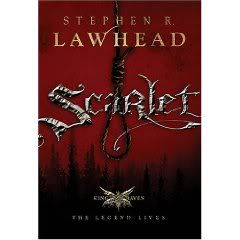I have been a little wishy-washy about if I should review Scarlet, the second book in the King Raven Series, since I didn’t review Hood, the first installment in the King Raven Trilogy (yet). But I thought I should write it down while it was still mostly fresh in my mind. I’ll get back to Hood later!
My first encounter with Stephen Lawhead was when I was given a used copy of his epic novel, Byzantium. Wow, I really liked that book! That was maybe 9 years ago, and I got sidetracked with Ted Dekker and other writers for a while, but always knew I would go back to read some more Lawhead at some point.
I can’t remember how long ago I picked up Hood, the premiere book in the King Raven Series, but even after I bought it I didn’t read it right away. This summer I finally got around to reading it, and I really enjoyed it. Basically the King Raven Series places the story of Robin Hood in medieval Wales – a completely different context than that story has ever been presented in. It’s a fun twist on familiar characters, but even with such a popluar legend as the foundation, the story is anything but predictable.
Hood is all about the character Bran ap Brychan, who becomes King Raven – Rhi Bran y Hud. In Scarlet, the story shifts to William Scatlocke, aka Will Scarlet, and his run with King Raven and his forest people. It’s still very much about King Raven, but as told from Scarlet’s point of view.
It took me a while to get into all of the Welsh and Norman names (thankfully there is a pronunciation guide at the beginning of both books!) and once I got the hang of them the book felt much more comfortable. Will’s narrative is constantly interrupted by interjections from the scribe to whom he’s telling the story, a plot development tactic that at first was tedious, but became quite humorous and more easily inclusive in the narrative itself.
Ultimately Will is caught by the Sherrif and is scheduled to be hung as an example to the rest of the forest gang. He’s resigned himself to that and stalling for time by telling the ins and (mostly) outs of his adventures to the priest in charge of his care. The powers-that-be are in hopes that he will spill the beans about King Raven’s exact whereabouts as he is telling his story. Will is well aware of this and has no intention of revealing anything seriously important – amusing, yes, important to the overall story, yes, but not actually crucial information for those with whom he is sharing the story.
One thing that I always wrestle with in these kinds of stories is the combination of mythology with the Christian faith. Bran and his gang are all obvious believers in the Lord and followers of Christ. Yet they have in their company, even as an advisor, a houdolin – an ancient woman wise in some kind of mythical magic ways. She herself is very committed to Christ – I’m just not sure how the other ‘stuff’ meshes together with that faith.
Scarlet includes fun twists and turns, full-out forest warfare at one point, and disguised priests and clerics causing a fuss and creating a means for Will’s escape. There is also a strongly apparent commentary on the royalty of the time, with their shifting loyalties and constant betrayals.
There are some series that I just will not start to read until all the books are already published so that I can go directly from one to the next. This series is fun, and worthwhile reading, but not captivating enough to insist that I simply can’t wait for the final installment to come out. There was some time between my reading of Hood and Scarlet. Now, it will be at least February of 2009 (the scheduled release date) before I get to read the next one, Tuck. In this case that doesn’t bother me at all. In the case of Ted Dekker’s Circle Trilogy, that would have felt like waiting an eternity… I had to read them al one right after the other.
It will be interesting to see how I like Tuck. I was surprised with the change of perspective from Hood to Scarlet, and with Tuck the perspective will once again be shifted to focus on Friar Tuck. How the story stays together through this interesting literary transition is yet to be seen. I found that to be an interesting strategy for telling this King Raven story – having the 3 books each focus on a different character to ‘telling’ the story. I am always one for doing things a bit differently, so it appeals to me. We’ll see how it all really fits together, though, when Tuck rounds out this adventure.
I am enjoying the King Raven series. Scarlet was definitely a fun twist on things, and enough to keep me interested for the last book. Scarlet is not one of my ‘jump-up-and-down-and-tell-everyone-about-it’ kind of books, but I would still say it’s worth a read, especially if you like Robin Hood kinds of stories, or if you have enjoyed Stephen Lawhead’s writings before.







